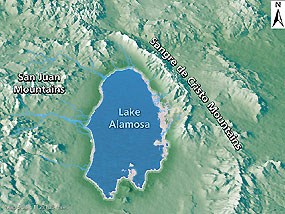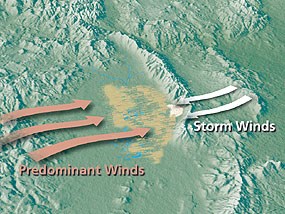Note: This is an Earthcache. There is no physical cache to find. Logging this Earthcache requires that you undertake an educational task relating to the specific Earth Science at the site.
Prior to logging this cache, click on Message this owner, or send an email with answers to the following questions:
- Which types(s) of sand dunes can you see from GZ?
- Are the types of dunes at this location subject to change? Why or why not?
- Do you think it's likely that the dunefield will increase in size?
- Required to log this cache: Please provide a photo of yourself or a personal item in the picture to prove you visited the site. Upload the photo with your log.
Formation of the Great Sand Dunes
The Sangre de Cristo Mountains were uplifted through the breaking apart and movement of large surface plates on Earth's surface. The San Juan Mountains were created by volcanic activity. These two mountain ranges created the San Luis Valley.
Sediments from both mountain ranges filled the deepest parts of the valley, along with water from mountain streams and rivers. The valley became covered by a huge lake geologists have named Lake Alamosa.

NPS Illustration
Through climate change, Lake Alamosa dried up and left a large sheet of sand. This sand was blown by the predominant southwest winds toward a low curve in the Sangre de Cristo Mountains. The wind funnels toward Mosca, Medano, and Music Passes and sand accumulates in this pocket.
The winds blow from the valley floor toward the mountains, but during storms, the winds blow back toward the valley. These opposing wind directions cause the dunes to grow vertically.

NPS Illustration
This combination of opposing winds, a huge supply of sand from the valley floor, and the sand recycling action of the creeks, are all part of the reason that these are the tallest dunes in North America.
Types of Dunes found in Great Sand Dunes NP
Star Dunes - Radially symmetrical, star dunes are pyramidal sand mounds with slipfaces on three or more arms that radiate from the high center of the mound. They tend to accumulate in areas with multidirectional wind regimes. Star dunes grow upward rather than laterally.
Barchan Dunes - A large, crescent-shaped dune lying at right angles to the prevailing wind and having a steep, concave leeward side with the crescent tips pointing downwind.
Reversing Dunes - Occurring wherever winds periodically reverse direction. These dunes typically have major and minor slipfaces oriented in opposite directions.
Transverse Dunes - A large, strongly asymmetrical, elongated dune lying at right angles to the prevailing wind direction. Transverse dunes have a gently sloping windward side and a steeply sloping leeward side.
Source: http://www.nps.gov/grsa/naturescience/sanddunes.htm
